II. The Medals
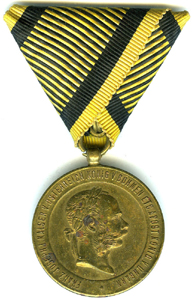
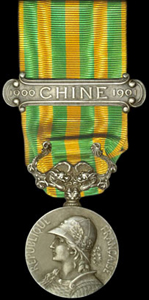
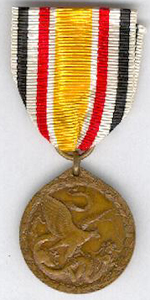
Austro-Hungary 1873 General War Service Medal, France China Commemorative and German Combattant’s China Campaign Medal
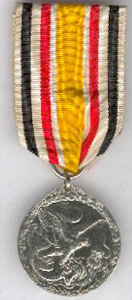
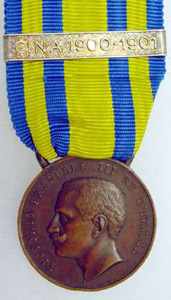
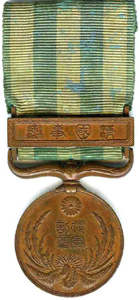
German Non-Combattant’s China Campaign Medal, Italy China Campaign Commemorative, Japan Relief of Peking Service Medal
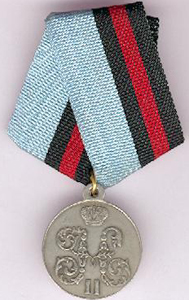

Imperial Russian Chinese Boxer Rebellion Medal Silver, Imperial Russian Chinese Boxer Rebellion Medal Bronze
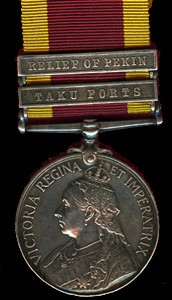
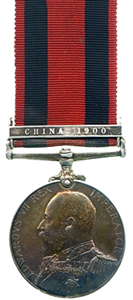
UK Third China War Medal and Transport Medal
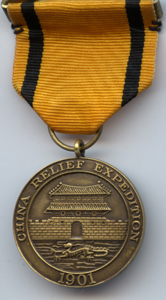
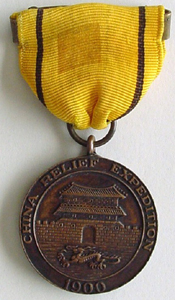
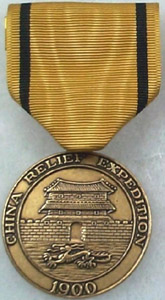
US Navy and Marine Corps China Relief Expedition Medal 1901 Version ON Type 2 Ribbon (400 Issued to USN only), 1900 Version1st Ribbon (thin black stripes) and 1900 Version 2nd (thicker black stripes) Ribbon
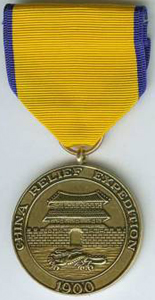
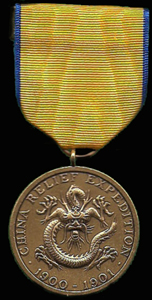
USN/MC China Relief Expedition Medal 3rd Ribbon (blue stripes) and US Army China Campaign Medal
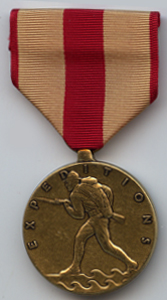
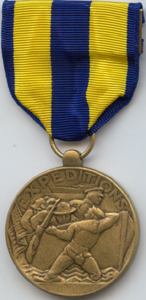
The USMC and USN Expeditionary Medals were Awarded for the lead-up to the Boxer Rebellion: Tientsin (12/4/1894 to 5/16/1895 and Chefoo 3/1 to 3/18/1895 and the USN Medal only for Peiping or Tientsin 11/4/1898 to 3/13/1899
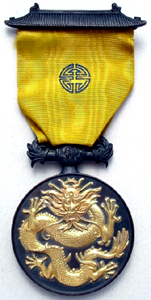
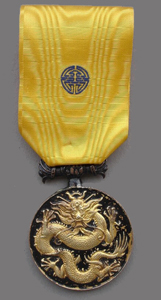
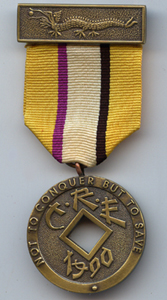
Military Order of the Dragon Medal with and without Top Bar and Enlisted Man’s* Imperial Order of the Dragon with Top Bar
*After 1930, Officers could join the Imperial Order of the Dragon. The Military Order of the Dragon was exclusively reserved for officers.
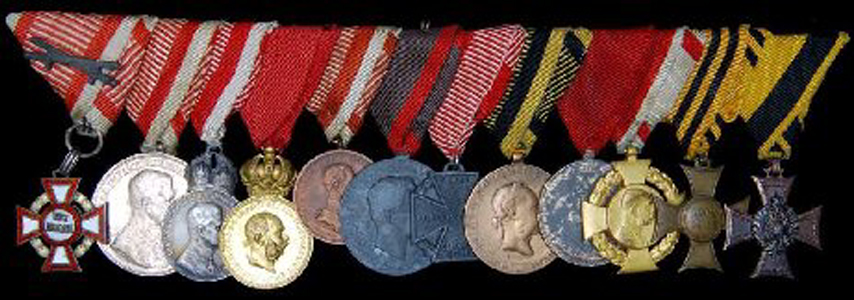
Austrian Group with War Medal
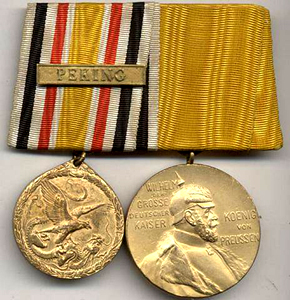
Imperial German Naval Infantry Combatant’s Group
The PEKING clasp was only awarded to members of the III Seebattalion (German Naval Infantry), who served under Leutnant Graf von Soden at the siege of the foreign legations in Peking.
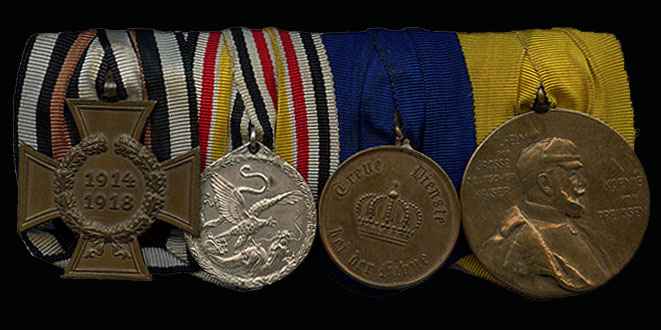
German Non-Combatant’s Group

Imperial Russian Group
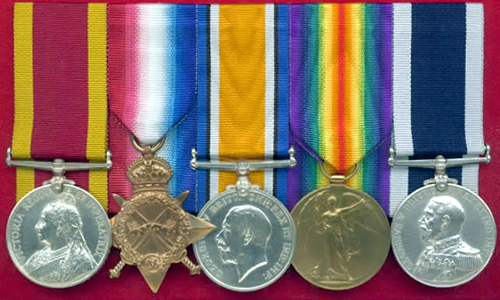
United Kingdom 3rd China Medal Group
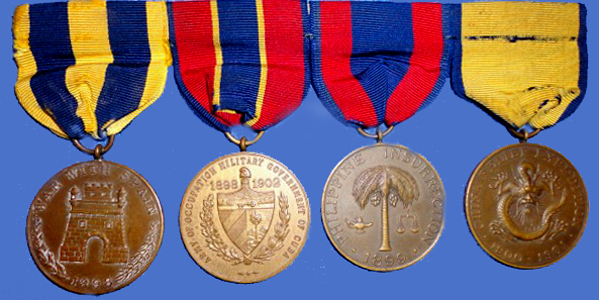
US Army Group
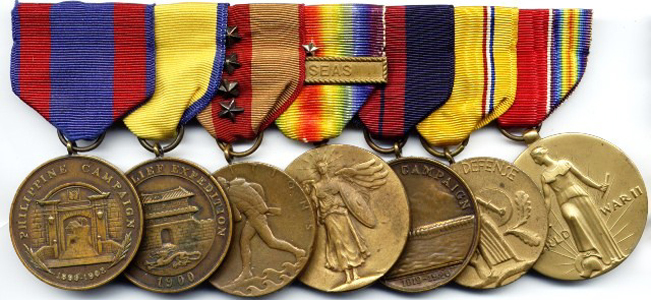
US Marine Corps Group
Qing Dynasty Order of the Double Dragon
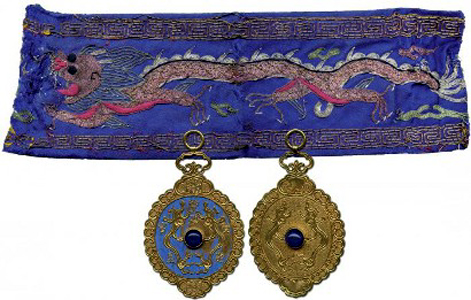
Order of the Double Dragon Transitional Type Third Class, Second Grade
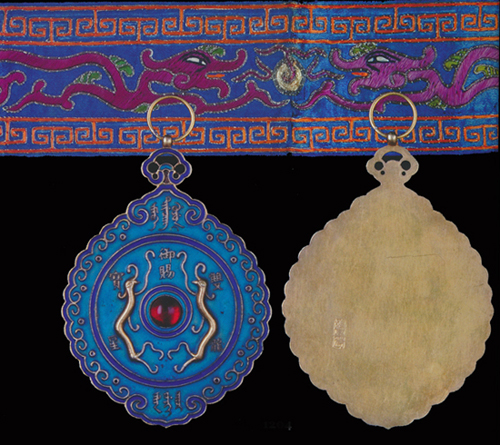
Order of the Double Dragon Transitional Type Third Class, Third Grade
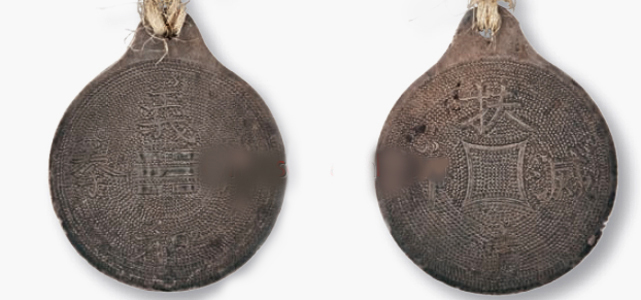
Harmony Society Boxer Medal
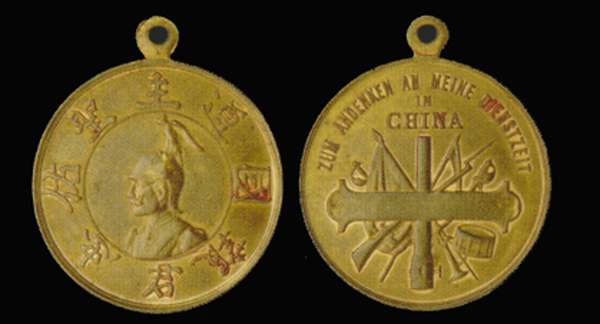
Merit Medal for Native Troops
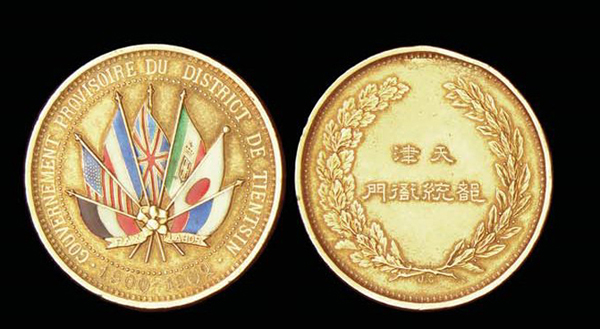
Tientsin Commemorative Gold Medal 1900-1902



Austro-Hungary 1873 General War Service Medal, France China Commemorative and German Combattant’s China Campaign Medal



German Non-Combattant’s China Campaign Medal, Italy China Campaign Commemorative, Japan Relief of Peking Service Medal


Imperial Russian Chinese Boxer Rebellion Medal Silver, Imperial Russian Chinese Boxer Rebellion Medal Bronze


UK Third China War Medal and Transport Medal



US Navy and Marine Corps China Relief Expedition Medal 1901 Version ON Type 2 Ribbon (400 Issued to USN only), 1900 Version1st Ribbon (thin black stripes) and 1900 Version 2nd (thicker black stripes) Ribbon


USN/MC China Relief Expedition Medal 3rd Ribbon (blue stripes) and US Army China Campaign Medal


The USMC and USN Expeditionary Medals were Awarded for the lead-up to the Boxer Rebellion: Tientsin (12/4/1894 to 5/16/1895 and Chefoo 3/1 to 3/18/1895 and the USN Medal only for Peiping or Tientsin 11/4/1898 to 3/13/1899



Military Order of the Dragon Medal with and without Top Bar and Enlisted Man’s* Imperial Order of the Dragon with Top Bar
*After 1930, Officers could join the Imperial Order of the Dragon. The Military Order of the Dragon was exclusively reserved for officers.
Medal Notes:
Austro-Hungary
The obverse of the circular silvered zinc alloy medal (sizes vary from 36 to 37.5mm) depicts the face with the laurel-crowned head of Emperor Franz Joseph I facing right circumscribed FRANZ JOSEPH I. KAISER V. OSTERREICH. KONIG V. BOHMEN ETC. APOST. KONIG V.UNGARN. The reverse is dated 2 DECEMBER 1873 (2 DEZEMBER 1873 after 1900) within a wreath of oak and laurel. The medal was instituted in 1873 and served to recognize participation in campaigns from 1848 to 1913 conducted by the Austro-Hungarian military. This is the only medal not specifically issued for the Boxer Rebellion. It was used to commemorate 16 separate campaigns, which include the 1900 and 1901 engagements in the Boxer Rebellion.
France
Established April 15, 1902, the 30mm silver obverse depicts the head of the Republic in tropical helmet and the inscription, REPUBLIQUE FRANCAISE. The reverse features crossed canons, anchor and flag in front of a Chinese pagoda with the inscription, CHINE above and 1900 and 1901 to the left and right. The medal was also awarded without the bar.
Germany
The 32mm China Campaign Medal was instituted by Kaiser Wilhelm II in May 1901 and was awarded to all German combatants and non-combatants who served in the Boxer Rebellion between May 30, 1900 and June 29, 1901. The obverse depicts a German eagle victorious over the Imperial Chinese dragon. The reverse of the medal was again edged with laurel leaves and showed a crowned "W II" monogram and the inscription, DEN SIEGREICHEN STREITERN- 1900 CHINA 1901 (To the Victorious Fighters). The non-combatants' version of the China Campaign Medal was identical except that it was made from polished steel and has the inscription, VERDIENST UM DIE EXPEDITION NACH CHINA (Served in the Expedition to China) on the reverse. The non-combatant’s version was also awarded to merchant seaman, who ferried supplies to China.
Imperial Russia
The light (non-combatants) and dark (combatants) bronze 28mm Medal for the Chinese Campaign 1900-1901features the crowned Nicholas II cipher on the obverse. The reverse has the dates 1900-1901above an anchor crossed by a rifle with fixed bayonet and saber on the reverse. The Cyrillic surround inscription loosely translates as FOR SERVICE IN CHINA. Variances exist particularly noted are the size of the anchors on the medal's reverse.
Italy
The 32mm bronze Commemorative Medal for the Campaign in China was established on June 23, 1901. The obverse depicts the bust of Victor Emmanuel III surrounded by the inscription, VITTORIO EMMANUELE III RE D’ITALY. There are two alternate reverses (1) CINA 1900-1901 on two lines surrounded by a laurel wreath and (2) a single line inscription CINA surrounded by a laurel wreath.There were a total of 2,325 medals awarded.The medal is encountered with and without a clasp. The clasp denotes participation during actual hostiles. The medal was also awarded for China service after cessation of hostilities without the clasp.
Japan
The obverse of the circular copper-colored bronze medal with decorated swivel suspension depicts a chrysanthemum crest above the four characters WAR MEDAL, all within the outstretched wings of a Phoenix. The reverse is inscribed with characters meaning the GREAT JAPANESE EMPIRE / MEIJI 33RD YEAR. The medal was created on 21 March 1901 for the members of the 5th Division of the Imperial Japanese Army and of the Japanese Imperial Navy who were part of the eight-nation alliance forces who lifted the two and a half month siege of the Foreign Legations in Peking (Beijing) during the Boxer’ Rebellion.
United Kingdom
The China War Medal 1900 was approved in 1901 for issue to land and sea forces. It was issued in silver to combatants and in bronze to native bearers, drivers and servants. It was also issued without a clasp. The medal used the same reverse as the two previous China War medals, a trophy-of-arms, with the obverse consisting of the bust of Queen Victoria. The medal was awarded to 555 naval personnel of the Australian Navy without a clasp, 256 men with the New South Wales Contingent, 197 with the Victorian Army and 102 naval personnel of the Gunboat Protector. No medal was issued with more than two of the available bars
The obverse of the Transport Medal bears the head of King Edward VII facing left with the legend EDWARD VII REX ET IMPERATOR. The reverse depicts a map of the world with a transport vessel and the inscription OB PATRIAM MILITIBUS PER MARE TRANSVECTIS ADJUTAM. Two clasps were awarded and a recipient could receive one or two clasps. The clasps were SOUTH AFRICA 1899-1902 and CHINA 1900. This medal was awarded to ship masters, first, second, third and chief Officers, first, second, third and chief Engineers as well as Pursers and Surgeons. The medal was also presented to those who served in 11 hospital ships employed during the two conflicts. A total of 1,822 medals were issued, 322 with CHINA 1900 only and 178 with dual clasps.
USN/MC China Relief Expedition Medal
This medal was issued to officers and enlisted men who served on shore in China with the Peking Relief Expedition between May 24, 1900 and May 27, 1901, or who were attached to one of the following vessels:
Brooklyn
Buffalo
Iris
Monocacy
Nashville
New Orleans
Newark
Solace
Wheeling
Yorktown
Zafiro
The ribbon of this medal originally bore the yellow and black motif. The colors were changed in 1915 to yellow and blue to correspond with those of the U.S. Army medal issued for similar service. The first 400 medals struck bear the date "1901." The die in use became damaged and replaced with a re-engraved die. This one, however, had the date "1900" which appears on all subsequent copies.
The obverse depicts the main gate to the walled city of Peking and the imperial dragon in profile, surrounded by the words, CHINA RELIEF EXPEDITION in the upper half and the date at the base. The reverse depicts an eagle with its wings displayed alight upon an anchor with draped chain, over the words FOR SERVICE in raised letters. At the base of the medal, and following the contour of its rim, there is an elongated wreath composed of oak on the left and laurel on the right. Following the contour of the upper portion of the medal are the words UNITED STATES NAVY or UNITED STATES MARINE CORPS in raised letters.
US Army China Campaign Medal
The China Campaign Medal was established by General Order 5 dated January 12, 1905. On the obverse is the Imperial Chinese five-toed dragon with the inscription CHINA RELIEF EXPEDITION around the upper border and the dates 1900 - 1901 at the bottom. On the reverse is a trophy composed of an eagle perched on a cannon supported by crossed flags, rifles, an Indian shield, spear and quiver of arrows, a Cuban machete, and a Sulu Kris. Below the trophy are the words FOR SERVICE. Around the border at the top are the words UNITED STATES ARMY and around the bottom are thirteen stars.
Medal GroupsAustro-Hungary
The obverse of the circular silvered zinc alloy medal (sizes vary from 36 to 37.5mm) depicts the face with the laurel-crowned head of Emperor Franz Joseph I facing right circumscribed FRANZ JOSEPH I. KAISER V. OSTERREICH. KONIG V. BOHMEN ETC. APOST. KONIG V.UNGARN. The reverse is dated 2 DECEMBER 1873 (2 DEZEMBER 1873 after 1900) within a wreath of oak and laurel. The medal was instituted in 1873 and served to recognize participation in campaigns from 1848 to 1913 conducted by the Austro-Hungarian military. This is the only medal not specifically issued for the Boxer Rebellion. It was used to commemorate 16 separate campaigns, which include the 1900 and 1901 engagements in the Boxer Rebellion.
France
Established April 15, 1902, the 30mm silver obverse depicts the head of the Republic in tropical helmet and the inscription, REPUBLIQUE FRANCAISE. The reverse features crossed canons, anchor and flag in front of a Chinese pagoda with the inscription, CHINE above and 1900 and 1901 to the left and right. The medal was also awarded without the bar.
Germany
The 32mm China Campaign Medal was instituted by Kaiser Wilhelm II in May 1901 and was awarded to all German combatants and non-combatants who served in the Boxer Rebellion between May 30, 1900 and June 29, 1901. The obverse depicts a German eagle victorious over the Imperial Chinese dragon. The reverse of the medal was again edged with laurel leaves and showed a crowned "W II" monogram and the inscription, DEN SIEGREICHEN STREITERN- 1900 CHINA 1901 (To the Victorious Fighters). The non-combatants' version of the China Campaign Medal was identical except that it was made from polished steel and has the inscription, VERDIENST UM DIE EXPEDITION NACH CHINA (Served in the Expedition to China) on the reverse. The non-combatant’s version was also awarded to merchant seaman, who ferried supplies to China.
Imperial Russia
The light (non-combatants) and dark (combatants) bronze 28mm Medal for the Chinese Campaign 1900-1901features the crowned Nicholas II cipher on the obverse. The reverse has the dates 1900-1901above an anchor crossed by a rifle with fixed bayonet and saber on the reverse. The Cyrillic surround inscription loosely translates as FOR SERVICE IN CHINA. Variances exist particularly noted are the size of the anchors on the medal's reverse.
Italy
The 32mm bronze Commemorative Medal for the Campaign in China was established on June 23, 1901. The obverse depicts the bust of Victor Emmanuel III surrounded by the inscription, VITTORIO EMMANUELE III RE D’ITALY. There are two alternate reverses (1) CINA 1900-1901 on two lines surrounded by a laurel wreath and (2) a single line inscription CINA surrounded by a laurel wreath.There were a total of 2,325 medals awarded.The medal is encountered with and without a clasp. The clasp denotes participation during actual hostiles. The medal was also awarded for China service after cessation of hostilities without the clasp.
Japan
The obverse of the circular copper-colored bronze medal with decorated swivel suspension depicts a chrysanthemum crest above the four characters WAR MEDAL, all within the outstretched wings of a Phoenix. The reverse is inscribed with characters meaning the GREAT JAPANESE EMPIRE / MEIJI 33RD YEAR. The medal was created on 21 March 1901 for the members of the 5th Division of the Imperial Japanese Army and of the Japanese Imperial Navy who were part of the eight-nation alliance forces who lifted the two and a half month siege of the Foreign Legations in Peking (Beijing) during the Boxer’ Rebellion.
United Kingdom
The China War Medal 1900 was approved in 1901 for issue to land and sea forces. It was issued in silver to combatants and in bronze to native bearers, drivers and servants. It was also issued without a clasp. The medal used the same reverse as the two previous China War medals, a trophy-of-arms, with the obverse consisting of the bust of Queen Victoria. The medal was awarded to 555 naval personnel of the Australian Navy without a clasp, 256 men with the New South Wales Contingent, 197 with the Victorian Army and 102 naval personnel of the Gunboat Protector. No medal was issued with more than two of the available bars
The obverse of the Transport Medal bears the head of King Edward VII facing left with the legend EDWARD VII REX ET IMPERATOR. The reverse depicts a map of the world with a transport vessel and the inscription OB PATRIAM MILITIBUS PER MARE TRANSVECTIS ADJUTAM. Two clasps were awarded and a recipient could receive one or two clasps. The clasps were SOUTH AFRICA 1899-1902 and CHINA 1900. This medal was awarded to ship masters, first, second, third and chief Officers, first, second, third and chief Engineers as well as Pursers and Surgeons. The medal was also presented to those who served in 11 hospital ships employed during the two conflicts. A total of 1,822 medals were issued, 322 with CHINA 1900 only and 178 with dual clasps.
USN/MC China Relief Expedition Medal
This medal was issued to officers and enlisted men who served on shore in China with the Peking Relief Expedition between May 24, 1900 and May 27, 1901, or who were attached to one of the following vessels:
Brooklyn
Buffalo
Iris
Monocacy
Nashville
New Orleans
Newark
Solace
Wheeling
Yorktown
Zafiro
The ribbon of this medal originally bore the yellow and black motif. The colors were changed in 1915 to yellow and blue to correspond with those of the U.S. Army medal issued for similar service. The first 400 medals struck bear the date "1901." The die in use became damaged and replaced with a re-engraved die. This one, however, had the date "1900" which appears on all subsequent copies.
The obverse depicts the main gate to the walled city of Peking and the imperial dragon in profile, surrounded by the words, CHINA RELIEF EXPEDITION in the upper half and the date at the base. The reverse depicts an eagle with its wings displayed alight upon an anchor with draped chain, over the words FOR SERVICE in raised letters. At the base of the medal, and following the contour of its rim, there is an elongated wreath composed of oak on the left and laurel on the right. Following the contour of the upper portion of the medal are the words UNITED STATES NAVY or UNITED STATES MARINE CORPS in raised letters.
US Army China Campaign Medal
The China Campaign Medal was established by General Order 5 dated January 12, 1905. On the obverse is the Imperial Chinese five-toed dragon with the inscription CHINA RELIEF EXPEDITION around the upper border and the dates 1900 - 1901 at the bottom. On the reverse is a trophy composed of an eagle perched on a cannon supported by crossed flags, rifles, an Indian shield, spear and quiver of arrows, a Cuban machete, and a Sulu Kris. Below the trophy are the words FOR SERVICE. Around the border at the top are the words UNITED STATES ARMY and around the bottom are thirteen stars.

Austrian Group with War Medal

Imperial German Naval Infantry Combatant’s Group
The PEKING clasp was only awarded to members of the III Seebattalion (German Naval Infantry), who served under Leutnant Graf von Soden at the siege of the foreign legations in Peking.

German Non-Combatant’s Group

Imperial Russian Group

United Kingdom 3rd China Medal Group

US Army Group

US Marine Corps Group
Qing Dynasty Order of the Double Dragon

Order of the Double Dragon Transitional Type Third Class, Second Grade

Order of the Double Dragon Transitional Type Third Class, Third Grade
The obverse shows an egret feathered field in blue with central cabochon sapphire on both sides and measures 39mm x 67mm including ring suspension. It also weighs 36.1g, with segment of beautiful original neck ribbon and modern lanyard.
The Order of the Double Dragon was instituted by Emperor Kuangsi on the 7th of February, 1882, as an award for meritorious services to the Throne. Initially it was awarded exclusively to foreigners, but its scope was later extended to include Chinese subjects from 1908.
This particular Order was awarded to Brigadier General F W B Gray CMG DSO (1867-1931), c.1901, for services rendered as Captain with the 3rd Brigade, 4th Punjab Infantry - part of the China Field Force during the Boxer Rebellion of 1900.
He is noted as having been present during the action at Tai Tao Ying.
Certificate Medal of the Leader of the K’an Trigram (Group) of Righteous Harmony Society Medal.
On the front side of the silver medal are four Chinese characters “I HO SHEN CH’UAN”, with one of the Eight Trigrams “K’AN” engraved in the middle. On the back side is the slogan of the society, “SUPPORT THE QING, DESTROY THE FOREIGN”. Based on the organization of Righteous Harmony Society and the material of the medal, the item is the certificate medal of the leader of the K’an Trigram (Group) of Righteous Harmony Society. The medal is extremely rare.
The Order of the Double Dragon was instituted by Emperor Kuangsi on the 7th of February, 1882, as an award for meritorious services to the Throne. Initially it was awarded exclusively to foreigners, but its scope was later extended to include Chinese subjects from 1908.
This particular Order was awarded to Brigadier General F W B Gray CMG DSO (1867-1931), c.1901, for services rendered as Captain with the 3rd Brigade, 4th Punjab Infantry - part of the China Field Force during the Boxer Rebellion of 1900.
He is noted as having been present during the action at Tai Tao Ying.
Certificate Medal of the Leader of the K’an Trigram (Group) of Righteous Harmony Society Medal.
On the front side of the silver medal are four Chinese characters “I HO SHEN CH’UAN”, with one of the Eight Trigrams “K’AN” engraved in the middle. On the back side is the slogan of the society, “SUPPORT THE QING, DESTROY THE FOREIGN”. Based on the organization of Righteous Harmony Society and the material of the medal, the item is the certificate medal of the leader of the K’an Trigram (Group) of Righteous Harmony Society. The medal is extremely rare.

Harmony Society Boxer Medal

Merit Medal for Native Troops

Tientsin Commemorative Gold Medal 1900-1902
Website Maintained by Vaudezilla